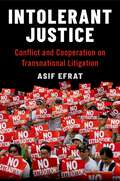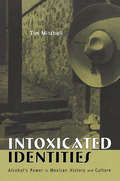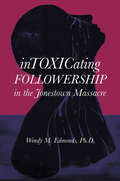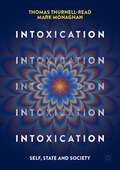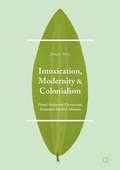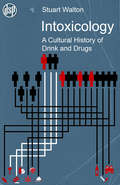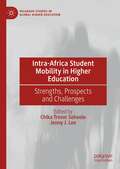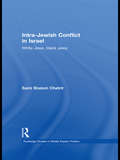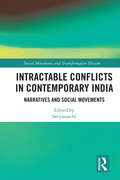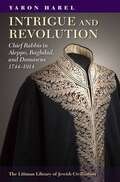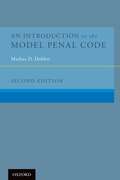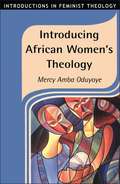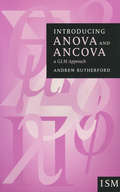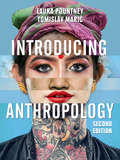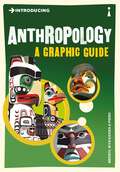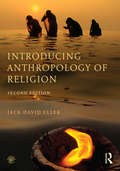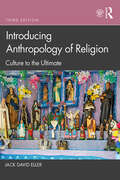- Table View
- List View
Intolerant Justice: Conflict and Cooperation on Transnational Litigation
by Asif EfratIn a globalized world, national legal systems often face dilemmas of international cooperation: Should our citizens stand trial in foreign courts that do not meet our standards? Should we extradite offenders to countries with a poor human rights record? Should we enforce rulings issued by foreign judges whose values are different from our own? Intolerant Justice argues that ethnocentrism--the human tendency to divide the world into superior in-groups and inferior out-groups--fuels fear and mistrust of foreign justice and sparks domestic political controversies: while skeptics portray foreign legal systems as dangerous and threatening, others dismiss these concerns. The book traces this dynamic in a range of fascinating cases, including the American hesitation to allow criminal trials of troops in the courts of NATO countries, the dilemma of extradition to China, and the European wariness toward U.S. civil judgments. Despite the growing role of law and courts in international politics, Intolerant Justice suggests that cooperation among legal systems often meets resistance and shows how this resistance can be overcome.
Intoxicated Identities: Alcohol's Power in Mexican History and Culture
by Tim MitchellFirst Published in 2004. Routledge is an imprint of Taylor & Francis, an informa company.
Intoxicated Identities: Alcohol's Power in Mexican History and Culture
by Tim MitchellFirst Published in 2004. Routledge is an imprint of Taylor & Francis, an informa company.
Intoxicating Followership: in the Jonestown Massacre
by Wendy M. EdmondsToxic behavior is on the rise in public safety organizations, businesses, politics, and churches, to name a few. Faced with unprecedented circumstances, there is a need to better understand leader/follower interdependence when destructive leaders are at the helm making harmful decisions. Toxic followership begins with the pioneering spirit of a trusted individual who, through creative manipulation, transforms our mindset whereby we can so easily become an extension of a toxic leader’s moral decay. There is a myth that the Jonestown tragedy is a distant episode in history that can only happen in certain environments with people unlike oneself. The survivor’s stories are reminders that without understanding the framework of toxic followership, the unsuspecting targets are prey, available for consumption by a leader with liquidated morals. This book is for those who desire to gain insight into the leader/follower dynamic in order to serve others by unmasking the dangers of toxic followership, provide prevention suggestions, and reveal followers' power, even in desperate situations.
Intoxicating Followership: in the Jonestown Massacre
by Wendy M. EdmondsToxic behavior is on the rise in public safety organizations, businesses, politics, and churches, to name a few. Faced with unprecedented circumstances, there is a need to better understand leader/follower interdependence when destructive leaders are at the helm making harmful decisions. Toxic followership begins with the pioneering spirit of a trusted individual who, through creative manipulation, transforms our mindset whereby we can so easily become an extension of a toxic leader’s moral decay. There is a myth that the Jonestown tragedy is a distant episode in history that can only happen in certain environments with people unlike oneself. The survivor’s stories are reminders that without understanding the framework of toxic followership, the unsuspecting targets are prey, available for consumption by a leader with liquidated morals. This book is for those who desire to gain insight into the leader/follower dynamic in order to serve others by unmasking the dangers of toxic followership, provide prevention suggestions, and reveal followers' power, even in desperate situations.
Intoxication: Self, State and Society
by Thomas Thurnell-Read Mark MonaghanWhat images come to mind when you read the word ‘intoxication’? What behaviour do you associate with the word ‘drunk’? When you hear the word ‘drug’, what images do you recall? This textbook provides an essential and thorough grounding in debates about the role of intoxication in contemporary society, from social and cultural perspectives. It examines intoxication in the broadest sense as including both legal and illegal substances and both culturally accepted and socially stigmatised practices. Given the pace of recent changes in policy and practice – from the increasingly common legalisation of cannabis, to the recent trend of sobriety amongst adolescents and young adults – this book stands out by offering both a through historical and theoretical overview and a topical and forward looking exploration of current debates. It adopts a multi-scale approach to examine wider patterns of change so it considers the subjective experiences of the role intoxication plays in the lives of individuals and groups, in the construction of diverse identities and how this differs by age, gender and ethnicity. The authors play particular attention to the way in which the state justifies interventions based on moral, health and criminal justice discourses and also consider the role played by other individuals and institutions, not least the mass media and the alcohol industry, in propagating and challenging common sense explanations of intoxication. It speaks to undergraduates, master's students and above, with a range of pedagogic features, and offers insights into policy and practice.
Intoxication, Modernity, and Colonialism: Freud’s Industrial Unconscious, Benjamin’s Hashish Mimesis
by Dušan I. BjelićThis book depicts how Freud’s cocaine and Benjamin’s hashish illustrate two critiques of modernity and two messianic emancipations through the pleasures of intoxicating discourse. Freud discovered the “libido” and “unconscious” in the industrial mimetic scheme of cocaine, whereas Benjamin found an inspiration for his critique of phantasmagoria and its variant psychoanalysis in hashish’s mimesis. In addition, as part of the history of colonialism, both drugs generated two distinct colonial discourses and, consequently, two different understandings of the emancipatory powers of pleasure, the unconscious, and dreams. After all, great ideas don't liberate; they intoxicate.
Intoxicology: A Cultural History of Drink and Drugs
by Stuart Walton“Like any good cocktail, this book brings together tasty ingredients in a delicious mix.” Boston HeraldIntoxicology is an addictive investigation into the history and culture of Narcotica - from the everyday use of alcohol, caffeine, and tobacco to the illicit realm of opiates, amphetamines, and hallucinogens. The book is a witty and provocative look at why intoxication has always been a part of the human experience - from our earliest Stone Age rituals to the practices of the ancient Greeks and Romans, right on up through the Victorian era and ending with a flourish in modern times - and why the use of mind-altering substances is, and will continue to be, an essential part, however transgressive, of civilization.“An insightful overview of humanity’s historical and cultural attachment to various intoxicants…it deserves a prominent place in the emerging discussion reshaping understanding and policies regarding intoxication and the use of drugs and alcohol.”Kirkus Reviews (starred)“Walton is particularly, and convincingly, engrossing, an elegant and forceful stylist.” Guardian“Hilariously well-versed…Walton’s wit is deliciously dry.” Seattle Weekly“A fluent plea for legalisation, by the only wine writer ever to admit that one of the best things about wine is the fact that it gets you pissed.” Class“Irvine Welsh and Stuart Walton have done more than most writers to change our attitudes to drug use.” Independent“It is the most refreshing book ever published on the subject…beautifully written.” Big Issue“Reading Stuart Walton's prose is a bit like going on some kind of trip. His erudition is dizzying.” Mail on Sunday“True to its theme, Walton's compelling and trenchant polemic is apt to induce a welter of sensations.” Evening Standard
Intra-Africa Student Mobility in Higher Education: Strengths, Prospects and Challenges (Palgrave Studies in Global Higher Education)
by Chika Trevor Sehoole Jenny J. LeeThis book examines student mobility within Africa. International student mobility is among the central activities of higher education internationalization. As the number of international students increase, so do the destinations, in both number and geographic diversity. Historically, international student mobility has followed South-North and North-North patterns. However, recent literature show the growth in North-South and South-South patterns of student mobility. There has also been a rise in regional mobility. In what is referred to in the book as intra-Africa mobility, the books explores and analyzes the patterns of intra-Africa mobility based on seven African countries: South Africa, Kenya,Uganda, Nigeria, Ghana, Senegal and Egypt. The editors and contributors addressthree central research questions: Why did the students choose the country they are studying in? Why did they choose the institution they are studying in? What are their academic and social experiences in these countries and their respective institutions? This book is the first comprehensive exploration of intra-Africa student mobility in a field that traditionally centers on the Global North.
Intra-European Student Mobility in International Higher Education Circuits: Europe on the Move (Palgrave Studies in Global Higher Education)
by Christof Van MolAdopting an interdisciplinary approach, this book empirically investigates the (im)mobility decisions, social network formation, sense of European identity and migratory aspirations of higher education students. It draws on a large-scale survey, in-depth interviews and focus groups, conducted in Austria, Belgium, Italy, Norway, Poland and the UK.
Intra-Jewish Conflict in Israel: White Jews, Black Jews (Routledge Studies in Middle Eastern Politics)
by Sami Shalom ChetritThis is the first book in English to examine the Mizrahi Jews (Jews from the Muslim world) in Israel, focussing in particular on social and political movements such as the Black Panthers and SHAS. The book analyses the ongoing cultural encounter between Zionism and Israel on one side and Mizrahi Jews on the other. It charts the relations and political struggle between Ashkenazi-Zionists and the Mizrahim in Israel from post-war relocation through to the present day. The author examines the Mizrahi political struggle and resistance from early immigration in the 1950s to formative events such as the 1959 Wadi-As-Salib rebellion in Haifa; the 1970s Black Panther movement uprising; the ‘Ballot Rebellion’ of 1977; the evolution and rise of the SHAS political party as a Mizrahi Collective in the 1980s, and up to the new radical Mizrahi movements of the 1990s and present day. It examines a new Mizrahi discourse which has influenced Israeli culture and academia, and the nature of the political system itself in Israel. This book will be of great interest to those involved in Middle East Studies and Politics, Jewish and Israeli Studies and Race and Ethnic Studies.
Intra-Jewish Conflict in Israel: White Jews, Black Jews (Routledge Studies in Middle Eastern Politics)
by Sami Shalom ChetritThis is the first book in English to examine the Mizrahi Jews (Jews from the Muslim world) in Israel, focussing in particular on social and political movements such as the Black Panthers and SHAS. The book analyses the ongoing cultural encounter between Zionism and Israel on one side and Mizrahi Jews on the other. It charts the relations and political struggle between Ashkenazi-Zionists and the Mizrahim in Israel from post-war relocation through to the present day. The author examines the Mizrahi political struggle and resistance from early immigration in the 1950s to formative events such as the 1959 Wadi-As-Salib rebellion in Haifa; the 1970s Black Panther movement uprising; the ‘Ballot Rebellion’ of 1977; the evolution and rise of the SHAS political party as a Mizrahi Collective in the 1980s, and up to the new radical Mizrahi movements of the 1990s and present day. It examines a new Mizrahi discourse which has influenced Israeli culture and academia, and the nature of the political system itself in Israel. This book will be of great interest to those involved in Middle East Studies and Politics, Jewish and Israeli Studies and Race and Ethnic Studies.
Intractable Conflicts in Contemporary India: Narratives and Social Movements (Social Movements and Transformative Dissent)
by SavyasaachiThis book attempts a representation of society in contemporary India through an ethnography woven around long-standing intractable conflicts — of displacement and rehabilitation, patriarchy, insurgency and counter-insurgency operations, and climate change. Each chapter in this volume offers a critical transformative narrative in response to these conflicts. It asks how social justice and equality is to be constructed and provides a fresh perspective. It is argued that social movements can no longer be concerned only with itemizing a checklist of demands; it is now necessary to be free of the hegemony of current frames, categories, concepts and principles, and to rethink the ‘promise’. The volume maintains that this effort to step out of the ‘endless waiting’ for delivery of a ‘promised value’ draws out the labour of transformative action. A valuable contribution to understanding social movements in India, this work challenges the established discourses around grassroots politics, progressive policies and legislations as well as radical mass movements. The book will interest students and researchers of social movements, conflict and peace studies, sociology and social anthropology, political science and development studies. It will also be useful to those working in the areas of human rights, social exclusion and inclusive policies.
Intractable Conflicts in Contemporary India: Narratives and Social Movements (Social Movements and Transformative Dissent)
by SavyasaachiThis book attempts a representation of society in contemporary India through an ethnography woven around long-standing intractable conflicts — of displacement and rehabilitation, patriarchy, insurgency and counter-insurgency operations, and climate change. Each chapter in this volume offers a critical transformative narrative in response to these conflicts. It asks how social justice and equality is to be constructed and provides a fresh perspective. It is argued that social movements can no longer be concerned only with itemizing a checklist of demands; it is now necessary to be free of the hegemony of current frames, categories, concepts and principles, and to rethink the ‘promise’. The volume maintains that this effort to step out of the ‘endless waiting’ for delivery of a ‘promised value’ draws out the labour of transformative action. A valuable contribution to understanding social movements in India, this work challenges the established discourses around grassroots politics, progressive policies and legislations as well as radical mass movements. The book will interest students and researchers of social movements, conflict and peace studies, sociology and social anthropology, political science and development studies. It will also be useful to those working in the areas of human rights, social exclusion and inclusive policies.
Intrigue and Revolution: Chief Rabbis in Aleppo, Baghdad, and Damascus, 1774-1914 (The Littman Library of Jewish Civilization)
by Yaron HarelThis is a book of unexpected drama: all eleven chief rabbis appointed in this period of unprecedented change in the Jewish communities of the Fertile Crescent became the subject of controversy and were subsequently dismissed. This took place against a background of events rarely discussed in the context of Jewish society: crime, hooliganism, slander, power struggles, sexual promiscuity, and even assaults and assassination attempts on rabbis. Using a wide range of testimonies gleaned from Ottoman Jewish, Arabic, and European sources, Yaron Harel paints a colourful picture of these upheavals set firmly in the social and political context of the time and far removed from the commonly accepted image of Jewish communities in the Ottoman empire. Jews were also affected by modernization and political conflict in the wider society of the time, and these too gave rise to power struggles. The chief rabbis were at the forefront of these confrontations, especially those that resulted from the new inclination towards Western culture. Most of them recognized that the challenges of modernization had to be met, although in a way that did not endanger religious principles. Their openness to change stemmed from a concern for the future of the communities for which they were responsible, but they were often vociferously opposed by those who were free from such responsibility. The communal politics that ensued were sometimes heated to the point of violence. In the latter years of the empire, many Jews came to support the Young Turks, with their promise of liberty and equality for all. The atmosphere of the time was such that rabbis had to develop political awareness and engage in Ottoman politics. This was another source of tension within the community since the new regime punished anyone suspected of opposition severely.This lively and fascinating study based on little-known sources offers a lens through which to view the Jewish society of the Ottoman empire at a time when all the traditional norms were being challenged.
INTRO TO MODEL PENAL CODE 2E C
by Markus D. DubberIn this second edition of his well-received introductory overview of the Model Penal Code, Markus Dubber retains the book's original aim to serve as an accessible companion to the Code. Professor Dubber unlocks the Model Penal Code's potential as a key to the study of American criminal law for law students and teachers, and for anyone else with an interest in understanding the basic contours of American criminal law. While the book's general goal and basic approach remain unchanged, its content has been thoroughly revised. Citations to primary and secondary materials have been updated and supplemented where appropriate. The American Law Institute's ongoing revision of the Code's sentencing and sexual offense provisions has been taken into account. Also, the comparative analysis found sporadically throughout the original edition has been expanded in places to provide additional context.
Introducing African Women's Theology (PDF)
by Mercy Amba OduyoyeThis volume describes the context and methodology of Christian theology by Africans in the past two decades and provides brief descriptions of sample treatments of theological issues, such as creation, Christology, ecclesiology and eschatology. The aim of the book is to lead interested persons to the sources of African women's Christian theology. Throughout an effort has been made to illustrate how African culture and the multi-religious context has influenced Christian women's selection of theological issues. The importance of daily life to theology and the attempt to probe the spirituality of African Christian women is also evident in this introduction to African women's theology.
Introducing Anova and Ancova: A GLM Approach
by Dr Andrew RutherfordTraditional approaches to ANOVA and ANCOVA are now being replaced by a General Linear Modeling (GLM) approach. This book begins with a brief history of the separate development of ANOVA and regression analyses and demonstrates how both analysis forms are subsumed by the General Linear Model. A simple single independent factor ANOVA is analysed first in conventional terms and then again in GLM terms to illustrate the two approaches. The text then goes on to cover the main designs, both independent and related ANOVA and ANCOVA, single and multi-factor designs. The conventional statistical assumptions underlying ANOVA and ANCOVA are detailed and given expression in GLM terms. Alternatives to traditional ANCOVA are also presented when circumstances in which certain assumptions have not been met. The book also covers other important issues in the use of these approaches such as power analysis, optimal experimental designs, normality violations and robust methods, error rate and multiple comparison procedures and the role of omnibus F-tests.
Introducing Anova and Ancova: A GLM Approach
by Dr Andrew RutherfordTraditional approaches to ANOVA and ANCOVA are now being replaced by a General Linear Modeling (GLM) approach. This book begins with a brief history of the separate development of ANOVA and regression analyses and demonstrates how both analysis forms are subsumed by the General Linear Model. A simple single independent factor ANOVA is analysed first in conventional terms and then again in GLM terms to illustrate the two approaches. The text then goes on to cover the main designs, both independent and related ANOVA and ANCOVA, single and multi-factor designs. The conventional statistical assumptions underlying ANOVA and ANCOVA are detailed and given expression in GLM terms. Alternatives to traditional ANCOVA are also presented when circumstances in which certain assumptions have not been met. The book also covers other important issues in the use of these approaches such as power analysis, optimal experimental designs, normality violations and robust methods, error rate and multiple comparison procedures and the role of omnibus F-tests.
Introducing Anthropology: What Makes Us Human?
by Laura Pountney Tomislav MarićThe perfect starting point for any student new to this fascinating subject, offering a serious yet accessible introduction to anthropology. Across a series of fourteen chapters, Introducing Anthropology addresses the different fields and approaches within anthropology, covers an extensive range of themes and emphasizes the active role and promise of anthropology in the world today. The new edition foregrounds in particular the need for anthropology in understanding and addressing today's environmental crisis, as well as the exciting developments of digital anthropology. This book has been designed by two authors with a passion for teaching and a commitment to communicating the excitement of anthropology to newcomers. Each chapter includes clear explanations of classic and contemporary anthropological research and connects anthropological theories to real-life issues at the local and global levels. The vibrancy and importance of anthropology is a core focus of the book, with numerous interviews with key anthropologists about their work and the discipline as a whole, and plenty of ethnographic studies to consider and use as inspiration for readers' own personal investigations. A clear glossary, a range of activities and discussion points, and carefully selected further reading and suggested ethnographic films further support and extend students' learning. Introducing Anthropology aims to inspire and enthuse a new generation of anthropologists. It is suitable for a range of different readers, from students studying the subject at school-level to university students looking for a clear and engaging entry point into anthropology.
Introducing Anthropology: A Graphic Guide (Introducing...)
by Merryl Wyn-DavisAnthropology originated as the study of 'primitive' cultures. But the notion of 'primitive' exposes presumptions of 'civilized' superiority and the right of the West to speak for 'less evolved' others. With the fall of Empire, anthropology became suspect and was torn by dissension from within. Did anthropology serve as a 'handmaiden to colonialism'? Is it a 'science' created by racism to prove racism? Can it aid communication between cultures, or does it reinforce our differences? "Introducing Anthropology" is a fascinating account of an uncertain human science seeking to transcend its unsavoury history. It traces the evolution of anthropology from its genesis in Ancient Greece to its varied forms in contemporary times. Anthropology's key concepts and methods are explained, and we are presented with such big-name anthropologists as Franz Boas, Bronislaw Malinowski, E.E. Evans-Pritchard, Margaret Mead and Claude Levi-Strauss. The new varieties of self-critical and postmodern anthropologies are examined, and the leading question - of the impact of anthropology on non-Western cultures - is given centre-stage. "Introducing Anthropology" is lucid in its arguments, its good humour supported by apt and witty illustrations. This book offers a highly accessible invitation into anthropology.
Introducing Anthropology of Religion: Culture to the Ultimate
by Jack David EllerThis clear and engaging guide introduces students to key areas of the field and shows how to apply an anthropological approach to the study of religion in the contemporary world. Written by an experienced teacher, it covers major traditional topics including definitions, theories and beliefs as well as symbols, myth and ritual. The book also explores important but often overlooked issues such as morality, violence, fundamentalism, secularization, and new religious movements. The chapters all contain lively case studies of religions practiced around the world. The second edition of Introducing Anthropology of Religion contains updated theoretical discussion plus fresh ethnographic examples throughout. In addition to a brand new chapter on vernacular religion, Eller provides a significantly revised chapter on the emerging anthropologies of Christianity and Islam. The book features more material on contemporary societies as well as new coverage of topics such as pilgrimage and paganism. Images, a glossary and questions for discussion are now included and additional resources are provided via a companion website.
Introducing Anthropology of Religion: Culture to the Ultimate
by Jack David EllerThis clear and engaging guide introduces students to key areas of the field and shows how to apply an anthropological approach to the study of religion in the contemporary world. Written by an experienced teacher, it covers major traditional topics including definitions, theories and beliefs as well as symbols, myth and ritual. The book also explores important but often overlooked issues such as morality, violence, fundamentalism, secularization, and new religious movements. The chapters all contain lively case studies of religions practiced around the world. The second edition of Introducing Anthropology of Religion contains updated theoretical discussion plus fresh ethnographic examples throughout. In addition to a brand new chapter on vernacular religion, Eller provides a significantly revised chapter on the emerging anthropologies of Christianity and Islam. The book features more material on contemporary societies as well as new coverage of topics such as pilgrimage and paganism. Images, a glossary and questions for discussion are now included and additional resources are provided via a companion website.
Introducing Anthropology of Religion: Culture to the Ultimate
by Jack David EllerThis clear and engaging guide introduces students to key areas of the field and shows how to apply an anthropological approach to the study of religion in the contemporary world. Written by an experienced teacher, it covers major traditional topics including definitions, theories, and beliefs, as well as symbols, myth, and ritual. The book also explores important but often overlooked issues such as morality, violence, fundamentalism, secularization, and new religious movements. The chapters all contain lively case studies of religions practiced around the world. The third edition of Introducing Anthropology of Religion is fully updated and contains additional content on material religion, visual religion, and affect theory, and a new chapter takes a closer look at medical and health topics. The author encourages the reader to engage throughout with the unifying themes of race, gender, and power, and how these themes are intertwined with anthropology of religion. Images, a glossary, and questions for discussion are included and additional resources are provided via a companion website.
Introducing Anthropology of Religion: Culture to the Ultimate
by Jack David EllerThis clear and engaging guide introduces students to key areas of the field and shows how to apply an anthropological approach to the study of religion in the contemporary world. Written by an experienced teacher, it covers major traditional topics including definitions, theories, and beliefs, as well as symbols, myth, and ritual. The book also explores important but often overlooked issues such as morality, violence, fundamentalism, secularization, and new religious movements. The chapters all contain lively case studies of religions practiced around the world. The third edition of Introducing Anthropology of Religion is fully updated and contains additional content on material religion, visual religion, and affect theory, and a new chapter takes a closer look at medical and health topics. The author encourages the reader to engage throughout with the unifying themes of race, gender, and power, and how these themes are intertwined with anthropology of religion. Images, a glossary, and questions for discussion are included and additional resources are provided via a companion website.
